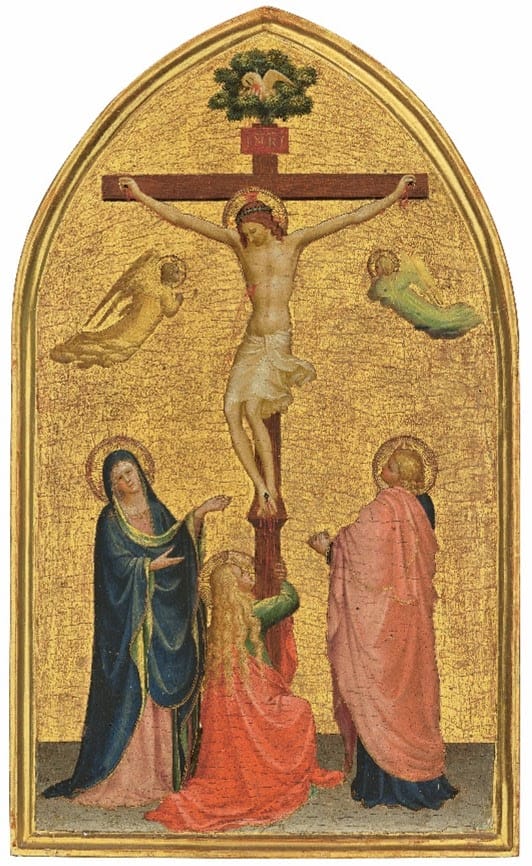London – The Crucifixion with the Virgin, Saint John the Baptist and the Magdalen at the Foot of the Cross, a pioneering early work by Fra Angelico – one of the greatest and most influential masters of the early Florentine Renaissance – will be a highlight in the Old Masters Part I Sale on 6 July, during Classic Week London (estimate: £4 million – 6 million). This panel was discovered and published by Francis Russell, Christie’s UK Deputy Chairman, in the Burlington Magazine in May 1996 (issue CXXXVIII, pp. 315-7). The discovery sparked widespread interest among scholars. Fra Angelico was one of the first painters to learn the lessons of contemporary sculpture and this work presents the market with his significant evolution in painted perspective: depicting the cross straight on in correct, logical, perspective without the false addition of showing the depth of the right cross post that was standard at the time. The work conveys emotional expression and poignancy that is amplified by the exemplary original condition of the figures which, having not been cleaned in recent times, provide the 21st century viewer with a remarkable chance to experience the artist’s wonderful sense of colour. It is thought to have been acquired by the 2nd Lord Ashburton who died in 1864 and has subsequently passed by descent. Pictures of this calibre very rarely come to the market. It will be on public view in New York from 10 to 14 June, before returning to London for the Classic Week pre-sale exhibition in London, on view from 1 to 6 July.
Francis Russell, Christie’s UK Deputy Chairman, commented: “It was a thrilling moment when I realised I was in the presence of an early masterpiece by Fra Angelico. This panel exemplifies his deep religious conviction. Intensely personal, it also expresses his understanding of the revolutionary achievement of the great Florentine sculptors of his time. The tenderness with which Christ is depicted is matched by the raw emotion of the Virgin and the pathos of the kneeling Magdalen clinging to the Cross, the thickness of which is revealed by the position of her arms. Every gesture is perfectly weighed. The sensitivity of the painter’s use of colour is evident in the way the blood both of Christ and the pelican above is matched in the robe of the Magdalen. With Fra Angelico nothing was accidental.”
Fra Angelico
Upon taking his vows as a Dominican friar in the small town of Fiesole outside Florence, Guido di Piero adopted the name Fra Giovanni da Fiesole. As a painter, the friar was unrivalled. Giorgio Vasari described him as having ‘a rare and perfect talent’ and his impact on Renaissance Florentine painting, and indeed the History of Art, cannot be overstated. His piety and modesty earned him the posthumous name ‘Fra Angelico’ or ‘Beato Angelico’ (‘Blessed Angelic One’) and in 1982, Pope John Paul II proclaimed his beatification, formally recognising the painter’s dedication to God during his lifetime.
The Pioneering Character of Design
Originally the centre of a devotional triptych commissioned by an unknown patron, the exact date of this panel is not known, but it has been placed in the period between circa 1419 and 1424, by the six scholars who have written about it. It has a significant place in the development of Florentine quattrocento painting. It is not known whether the patron who commissioned this work was aware of its pioneering character of the design.
The perspective of the cross is straight on to the viewer minus any false perspective showing the right hand side of the post, which was a standard element in paintings at the time, evidenced by the work of innumerable masters from Cimabue, Ugolino di Nerio, Simone Martini and Pietro Lorenzetti, to Giotto, Bernardo Daddi and Lorenzo Monaco to whose ‘school’ this Crucifixion was formerly attributed. Fra Angelico’s ‘frontal’ treatment of the Cross in this panel demonstrates what has been long understood: the artist was keenly aware of the work of revolutionary Tuscan sculptors of the early Quattrocento, such as Ghiberti and Brunelleschi. This is further demonstrated in Saint John the Baptist’s cascading mantle (attire) which appears to have been ‘modelled’ in sculptural terms. Art historian Diane Cole Ahl has also noted that the Saint’s features and stance were probably inspired by Ghiberti’s bronze trial piece of 1401-3 for the Sacrifice of Isaac (Florence, Bargello).
With a single exception (the intimate double-sided roundel in the Museo do San Marco), all Fra Angelico’s many subsequent depictions of the Crucifixion, including the twenty frescoes executed by him or under his supervision in the cells at San Marco, were to show the Cross in correct perspective. Many painters, however, continued to adhere to the earlier pattern for some time, particularly in more remote regions.
Fra Angelico used colour for compositional purposes in this panel – with pink, deep blue, greens and red echoed across the attire of the figures and beyond, presenting a fascinating symmetry of colour, subtly deployed to bind the panel with the wings of the triptych. The artist’s wonderful chromatic sense can still be experienced thanks to the remarkable condition of the figures; the timbre (tones and character) illustrates the artist’s personal taste, while the colours of the Virgin’s robes and the Magdalen’s dress were determined by convention.
